Bronze Eagle Statues
As an important part of ancient Chinese civilization, bronze carries rich historical and cultural information. Among many bronzes, bronze statues with eagle as the theme have unique artistic value and cultural connotation. The eagle was regarded as a sacred bird in ancient Chinese culture, a symbol of strength, majesty and nobility. From the Neolithic Age to the feudal society, the image of the eagle has been present in all stages of the development of Chinese art, and is especially prominent in bronzes. This study will take a comprehensive look at bronze eagle statues, exploring their historical evolution, artistic features and cultural connotations, and revealing the importance of this artistic subject in ancient Chinese civilization.
-
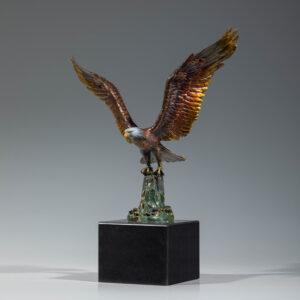
 Product on salemetal eagle sculptureOriginal price was: $1,380.00.$1,280.00Current price is: $1,280.00.
Product on salemetal eagle sculptureOriginal price was: $1,380.00.$1,280.00Current price is: $1,280.00. -

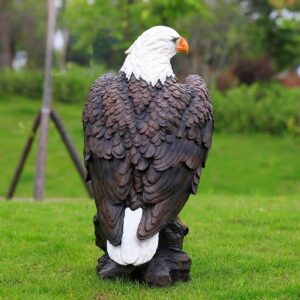 Product on saleSimulation resin sculpture eagle ornamentOriginal price was: $530.00.$450.00Current price is: $450.00.
Product on saleSimulation resin sculpture eagle ornamentOriginal price was: $530.00.$450.00Current price is: $450.00. -
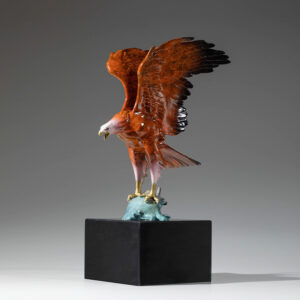
 Product on salebronze eagle statue PendantOriginal price was: $1,800.00.$1,720.00Current price is: $1,720.00.
Product on salebronze eagle statue PendantOriginal price was: $1,800.00.$1,720.00Current price is: $1,720.00. -

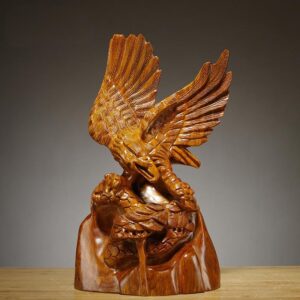 Product on salePearwood Carved Animal Eagle OrnamentOriginal price was: $680.00.$650.00Current price is: $650.00.
Product on salePearwood Carved Animal Eagle OrnamentOriginal price was: $680.00.$650.00Current price is: $650.00. -

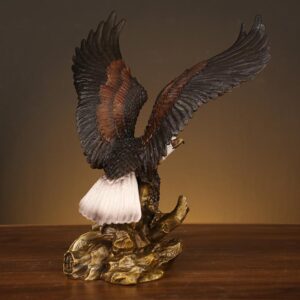 Product on saleEagle with Wings All BrassOriginal price was: $980.00.$950.00Current price is: $950.00.
Product on saleEagle with Wings All BrassOriginal price was: $980.00.$950.00Current price is: $950.00. -
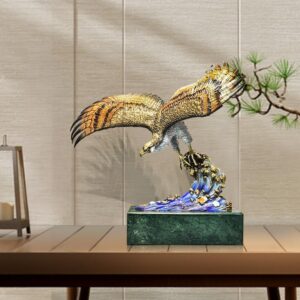
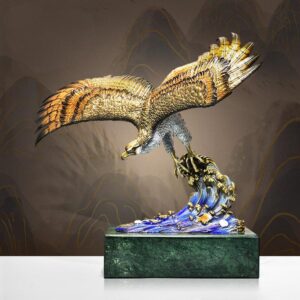 Product on saleeagle statue bronzeOriginal price was: $2,500.00.$2,400.00Current price is: $2,400.00.
Product on saleeagle statue bronzeOriginal price was: $2,500.00.$2,400.00Current price is: $2,400.00. -
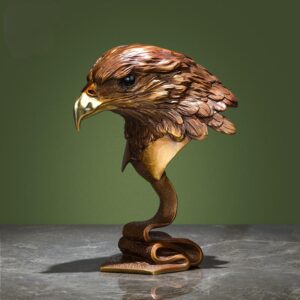
 Product on saleFull Bronze Eagle OrnamentOriginal price was: $1,300.00.$1,100.00Current price is: $1,100.00.
Product on saleFull Bronze Eagle OrnamentOriginal price was: $1,300.00.$1,100.00Current price is: $1,100.00.
The Symbolism of the Eagle in Ancient Chinese Culture
The origin of the eagle’s totem worship
The eagle has a profound historical origin in ancient Chinese culture, which can be traced back to the totem worship of primitive society. In the culture of the Chinese people, the eagle is regarded as the embodiment of God and the messenger connecting heaven and earth. In religious consciousness over thousands of years, the eagle has been endowed with a mysterious color, and has been worshipped as a “divine bird”, “bird of heaven” and “divine eagle”. This worship originated from the ancient people’s reverence for the power of nature, the eagle as a raptor, its mighty, high-flying characteristics make it become the object of human worship.
In Eurasia, the eagle was a sacred bird favored by ancient royalty and kings. As the highest-flying and most solitary of birds, the eagle has been a symbol of power and honor since ancient times, representing the majesty of royalty and rulers.
The Evolution of Eagle Symbolism
With the development of society and cultural changes, the symbolism of the eagle is also constantly enriching and evolving. In traditional culture, the stone eagle is regarded as auspicious, associated with courage, strength, majesty and other meanings. In ancient architecture, gardens and scenic decorations, the image of the eagle often has important cultural significance.
Especially in the period of Liao and Jin, eagle hunting is not only a means of hunting, but also become a symbol of political and military power. Liao and Jin once because of the competition for high-quality falcons and broke out in conflict, which is sufficient to prove that the eagle hunting in the northern peoples of the cultural status is extremely important!
Artistic characteristics of bronze eagle statues
Artistic styles in different periods
Bronze eagle statues show different artistic styles in different historical periods. In the Shang Dynasty, the bronze eagle statue is characterized by a combination of realism and exaggeration, such as the artistic modeling of the owl is both realistic and exaggerated, the overall appearance of the heavy, majestic, reflecting the aesthetic concepts of the Shang Dynasty bronze art.
In the Spring and Autumn and Warring States period, the design of the bronze eagle statue is more skillful and flexible. The design of the eagle head-shaped lid lifting pot is very clever, the lid for the eagle head shape, with the eagle beak for the flow, beak open and close flexible, vivid and realistic modeling, rich in artistic value. This design reflects the high level of bronze craftsmanship and unique artistic conception of the Warring States period.
In the Han Dynasty, the “flying eagle on horseback” styled bronze set of ingenious artistic ideas and high technical standards of craftsmanship in one, is considered to be “the top of the sculpture art”. This style reflects the peak of the Han Dynasty bronze art.
Bronze eagle statue technology
The production of bronze eagle statues requires a high level of craftsmanship. During the Shang Dynasty, the casting process of bronze was already very advanced, and it was able to produce bronze vessels with complex shapes and rich decorations such as the Owl Zun. Owl Zun lid placed three-dimensional round carving of small owls and small dragons, mainly decorated with owls, kui dragons, snakes and other relief animals, these decorations on the surface of the vessel to form a rich variety of visual effects.
In the Warring States period, the production of the eagle head lifting beam pot is also very exquisite. The lid of this pot is made in the shape of an eagle’s head, with an eagle’s beak as the stream, and the beak opens and closes flexibly, which is skillfully designed and vividly and realistically modeled. This craft reflects the high degree of development of bronze production technology in the Warring States period.
In the han dynasty production process has reached a very high level, is considered to be “the top of the sculpture art”. This level of craftsmanship, and the high degree of development of the Han dynasty bronze casting technology is inseparable.
The cultural connotation of bronze eagle statues
Eagle worship and religious beliefs
The cultural connotation of bronze eagle statues is closely related to the ancient eagle worship and religious beliefs. In Chinese culture, the image of eagle can be traced back to the totem worship in primitive society, and the eagle is the embodiment of God. In the religious consciousness over thousands of years, the eagle was covered with mysterious colors and worshipped as a divine bird, heavenly bird and divine eagle.
In the Shang society, the religious worldview dominated. Bronze as an important ritual activities in the ritual, with owls such as the image of the bird to cast has its special historical origin. The owl was considered to be a symbol of the underworld as it appeared day and night in the totem of the Shang. This concept was fully embodied in the Shang Dynasty bronzes, such as the shape and decoration of the owl Zun reflects this religious belief.
Eagle and military power
In ancient society, the eagle is also closely related to military power. Especially in the period of liao and jin, eagle hunting is not only a means of hunting, but also become a symbol of political and military power. Liao Jin two countries once because of the competition for high-quality falcons and broke out in conflict, which is enough to prove that the eagle hunting in the northern peoples of the cultural status is how important.
The meaning of the bronze sculpture “Horse on Flying Eagle” is the same as the stone sculpture “Horse on Huns” in front of the tomb of Huo Daizi, who led the army to occupy the Hexi Corridor and defeated the Xiongnu in the north desert during the time of Emperor Wu of the Han Dynasty, and made great achievements in the war, both of them are the memorials for the owner of the tomb’s victory over the Xiongnu. This shows that in the Han Dynasty, the eagle has become a symbol of military victory.
Eagle and political symbols
In ancient society, the eagle also has important political symbolism.” In the bronze vessel in the shape of “Horse Treading Flying Eagle”, the bird under the horse’s hooves is the eagle, the symbol of power on the crown of the Xiongnu. This shows that the eagle has become a symbol of power in ancient society.
In the decoration of ancient buildings, gardens and scenic spots, stone eagles often have a large market, which is related to the fact that stone eagles were regarded as auspicious objects, and the meaning of courage, strength and majesty in ancient Chinese culture. This indicates that the eagle not only has religious and military significance in ancient society, but also has important political symbolism.
